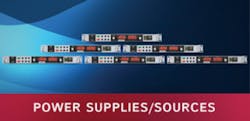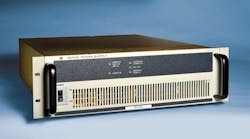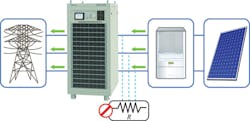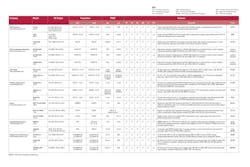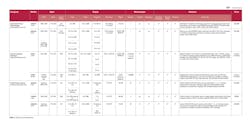Higher power density, better ease of use, and unique operating modes are among the more important characteristics distinguishing today’s power supplies and sources. Flexible autoranging or multiranging DC supplies, which support output voltage and current combinations within the supply’s maximum power, voltage, and current ratings, have become more widely available. And, direct control of constant current or constant voltage output—so-called CC or CV priority—is a relatively new mode that ensures difficult loads are correctly driven. Table 1 (found at the end of the article) compares several DC power supplies.
For AC sources, simplified parallel/polyphase operation improves ease of use and supports higher productivity. Combining a power analyzer and an AC source within the same chassis is another way in which some recently introduced AC sources are streamlining test setups and saving cost. Table 2 (found at the end of the article) compares several AC sources.
Both DC supplies and AC sources may include special solar-related capabilities.
DC supplies
Power density
The input for low-power supplies typically is 115 VAC single phase, changing to a higher voltage and possibly three-phase operation for supplies larger than about 5 kW. Nevertheless, it’s not always convenient to provide three-phase power for 5-kW supplies. Instead, B&K Precision has designed the 2U PVS Series to operate from a 220-V single-phase input.
According to James Schada, senior product marketing manager at the company, “To achieve higher efficiency and power density in our high-power programmable DC power supplies, we use phase-shifted full-bridge converter topology with high switching frequency and good airflow management. For instance, our PVS Series power supplies use switching frequencies greater than 40 kHz. Higher frequency translates to smaller components but adds to switching loss. To minimize switching loss, soft switching techniques were implemented.” He concluded, “Good airflow management increases the efficiency of the fans used to keep temperatures low. In our designs, air is drawn in from the front panel, and the fans pull the air through the rear so that it does not circulate inside the power supply.”
Careful thermal design also supports the high power density of the GW Instek PSU Series 1U rack-mount supplies. Sales director Reginald Bale said, “The heat dissipation design on the front and rear panels allows the PSU series to be placed on top of each other to augment the available power. A 4U height with parallel connections can realize the maximum 800-A or 6,080-W output.”
Adam Pitel, vice president at Magna-Power Electronics, discussed some of the business decisions related to manufacturing high-power supplies. In his experience, most supplies larger than about 1.5 kW are made to order. This realization has driven the company to vertically integrate activities from transformer winding to surface-mount assembly and sheet-metal fabrication. By maintaining tight control of all these aspects, Pitel claims that Magna-Power can turn around made-to-order products within two weeks.
Specifically, he commented on the balance between cost and performance in high-power supplies. “For increasing power density, the power supply’s internal layout and heat management are just as important as the devices and materials themselves,” he said. “With internal heat-sink fabrication capability, Magna-Power has focused on innovative heat-sink design and unique power stage layouts, allowing the company to better transfer and remove heat while still utilizing conventional IGBTs in its switched-mode design. This design methodology allows the company to compete with industry-leading power densities while maintaining competitive product pricing.” The company’s SL Series is a good example of high power density with models up to 6 kW in a 1U package (Figure 1).
Courtesy of Magna-Power
Features
Kepco has continued to offer autoranging power supplies, or as they also are called, multiranging, with the 1U Series KLP 1,200-W supplies. Instead of having a rectangular I-V characteristic, this type of supply provides any combination of V and I within a constant-power hyperbola. Where a conventional 100-W supply could have 20-V and 5-A limits, an autoranging supply additionally might allow 30 V at 3.3 A or 10 V at 10 A—both within the 100-W power limit. Typically, manufacturers support about a 3:1 variation in voltage and current, minimizing the need to buy lots of slightly different conventional supplies. B&K Precision’s Model 9201 also is multiranging, supporting outputs between 60 V at 3.3 A and 20 V at 10 A within its 200-W limit.
Keysight Technologies’ Model N6786A module for the N6700 Modular Power System takes a different approach. Within the basic 80-W power capability, you can select one of four rectangular operating areas: 20 V at ±4 A, 15 V at ±5 A, 10 V at ±6.7 A, and 6 V at ±8 A. As this example shows, there can be trade-offs when exchanging voltage for current. Because power loss is proportional to current squared, thermal considerations come into play as the output current increases. A 5-W derating of the output power accompanies the 15-V and ±5-A setting, increasing to 13 W on the 10-V range and culminating in a 32-W reduction at 6 V.
The N6786A’s operation is characteristic of a two-quadrant source-measure-unit (SMU). Compared to a conventional power supply that can only source power, an SMU also can sink power. This means, for example, that an SMU can emulate a battery charger and also act as a load for a battery in a discharge test. Therefore, SMU power ratings can be as much about dissipation capabilities as they are about output.
This point is clearly evident in Keysight’s Advanced Power System power supplies. These supplies provide two-quadrant operation but limit power sinking to 10% of the maximum output rating. For example, the N6973A 2-kW supply can sink 3.33 A at 60 V—200 W. To sink more power, one or two optional N7909A power dissipater units must be used in conjunction with the supply. Each N7909A adds 1-kW sinking capability.
Keithley Instruments, a Tektronix company, has developed SMUs for many years, the Model 2450 being the latest. Similar to Keysight’s 10% power sinking limitation, the 2450 provides 200 V and 1 A, but not simultaneously. The unit is rated for 20-W output or dissipation and operates in all four quadrants. A large 5-inch full-color touchscreen supports an icon-based menu system and displays results in a number of formats.
According to Robert Green, senior market development manager at the company, the quest for more energy-efficient products requires higher accuracy low-level measurements. He said, “Keithley’s latest power supply offerings combine built-in readback capability with greater sensitivity and resolution than earlier models. These supplies can make measurements with up to 6½ digits of resolution. Voltage output measurements can be resolved down to 100 µV. These supplies measure load currents from 100 nA to amps and can resolve down to 10 nA.” Also addressing low-level needs, Keysight’s N6781A and N6785A SMUs feature seamless current measurement that handles nA to A without changing ranges.
Kepco’s BOP bipolar power supplies also have four-quadrant operation but with ratings up to 1 kW. As explained by Mark Kupferberg, executive vice president-power solutions, “To minimize size and increase efficiency, Kepco has pioneered power recuperation in the BOP line of 1-kW bipolar modules. When the BOPs are sinking energy from a load, such as a magnet, the power is converted into AC and injected back into the AC mains. This reduces the amount of electricity required and the heat discharged into the operating environment. Kepco’s latest use of recuperation technology is in the BOP-GL Series of inductive-load-optimized bipolar power supplies. The BOP 10-100GL (Figure 2) provides up to 100 amps of source and sink power in a 3U package.”
Courtesy of Kepco
Solar
Alternative energy sources, such as solar, have their own control issues. A solar panel’s IV characteristic is not rectangular. To mimic a panel’s performance, the correct IV relationship needs to be programmed into a DC supply. Some products, such as Chroma Systems Solutions’ 62000H-S Series, have it built in.
Solar-simulating power supplies are used to test maximum power point (MPPT) algorithms in PV inverters. Basically, the inverter alters its input impedance so that the current it draws from the solar panel corresponds to the highest power on the panel’s output characteristic. Because of clouds and other disturbances, a panel’s output varies quickly, and it’s the job of the inverter’s MPPT algorithm to track the maximum power point as it changes. Up to 100 IV curves can be stored in 62000H-S supplies to represent various operating conditions. Switching from one curve to another and the time between each state are programmable.
AC sources
The simplest AC source is a variable autotransformer, generically called a Variac, regardless of any trademark implications. Variacs are great, unless you need a different frequency, have to inject transients, or want a waveform other than the distorted and noisy sine wave that your mains supply happens to be exhibiting at the time. And, there is no isolation from input to output.
Modern AC sources address all these problems as well as many not listed, such as providing a three-phase output from a single-phase input (or vice versa) and simulating various kinds of multiphase anomalies. These sources tend to be modular so that you can parallel units to get higher power. Some manufacturers support linking single-phase units for two- or three-phase applications.
Features
AC sources are differentiated by their basic technology as well as by output power and the number and type of controllable functions. Within the Pacific Power Source models listed in Table 2, the 110ADX 1-kVA product is “targeted at basic AC power testing or frequency conversion requirements where programmability and accuracy are important,” as stated in the ADX series datasheet.
High-frequency pulse-width modulation is used for power conversion, yielding a reasonably lightweight, responsive, and cost-effective unit. Comparing the 110ADX with the company’s 360AMX highlights the 6:1 difference in power, but also the much higher frequency range and lower ripple accompanying the linear AMX design. Similar differences exist between the linear 6-kVA AMX and the switching ASX units, supporting a $1,400 premium for the AMX. Herman vanEijkelenburg, director of marketing at the company, confirmed that, “While less efficient overall, linear AC power sources offer superior bandwidth, slew rates, and transient response compared to switchers.”
Sources may support functions such as programmable output impedance, harmonic synthesis, or transformer output. It’s all about flexibility. UPC Studio is Pacific Power software that works with the company’s sources to provide waveform editing and control of output sequences.
VanEijkelenburg continued, “Increased demand for product testing is driven by both the need to improve product quality and to meet increasing levels of regulatory requirements. This requires more sophisticated test capabilities and demands more functionality from the test equipment used. An increase in power levels is driven by the need to improve energy efficiency of an increasing range of products. This requires AC power simulation and measurements. Pacific Power Source’s AC power sources use full-featured programmable controllers to meet these needs.”
Given Chroma’s involvement in DC supplies for solar array and inverter testing, it’s not surprising that the company also has developed the four-quadrant 61800 Series regenerative grid simulator AC source (Figure 3). As Steve Grodt, director of business development, explained, “There are two main features that differentiate the 61800 series from earlier models. The first one is the regenerative function which allows the 61800 unit to sink power generated from the UUT (for instance, a grid-tied PV inverter) and through conversion feed the power back to the main grid instead of dissipating the generated power by a dummy resistor as heat.
Courtesy of Chroma Systems Solutions
“The second feature is that the unit is capable of delivering maximum phase output voltage up to 400 VLN (692 VLL) which is required for UUT (such as grid-tied PV inverter) overvoltage protection testing, especially for the one with 480-V input voltage.” Grodt concluded, “The 400 VLN output voltage is accomplished without implementation of a boost transformer, and the benefit is that the output voltage transient performance will not be affected.”
Regeneration (or recuperation as Kepco describes its DC supply technology) isn’t just an ecologically friendly approach: it’s very practical as well. Chroma’s 61860 model listed in Table 2 has a 60-kVA rating and operates in all four quadrants. Up to five units can be paralleled for 300-kVA capacity. Regeneration allows the sources to act like a large load for PV inverter and wind energy systems but without the very significant dissipation otherwise required.
Associated Power Technologies’ sources provide the sine-plus-transient type of test waveform very often needed for production testing. They do not support custom waveform generation or waveform sequencing. However, if you don’t need these capabilities, the units may be economical solutions for your application.
Further addressing the flexibility needed in production test, these sources support the smartCONFIG feature. As described by Nicholas Piotrowski, technical project leader, “The smartCONFIG capability on our 300XAC & 400XAC Series provides a configurable output, eliminating the need for multiple dedicated sources to meet the power requirements of the load. Our smartCONFIG feature will provide an output voltage in single phase, split single phase, three phase, or DC voltage. The switching from one output to another is accomplished via the front-panel interface or software GUI. There is no need to reconfigure any internal hardware.”
Total application solution
Often, seemingly small features can make all the difference in addressing an application. For example, Keysight’s Emidio Cianfaglione, product planning and marketing manager, commented, “Our unique patented dynamic up and down programming circuits allow ultrafast system throughput while minimizing heat and its impact on reliability and size.” If down-programming response time is particularly important in your application, this could be a solution.
In another example, Chroma’s 62000H series can create complex DC transient waveforms. As stated on the datasheet, “This capability allows devices to be tested to DC voltage dropouts, spikes, and other voltage variations, making the supplies an ideal choice for aerospace device testing, inverter testing, and other devices which will experience voltage interrupts.”
Both DC supplies and AC sources offer a wide range of features in addition to the basic ones shown in Tables 1 and 2. To determine that a particular unit will suit your needs, contact the manufacturer and arrange to borrow a unit to try in your test setup. Even if the product works perfectly in your application, the required characteristics still must be guaranteed on the datasheet.
CLICK TO ENLARGE TABLE
CLICK TO ENLARGE TABLE
For more information
